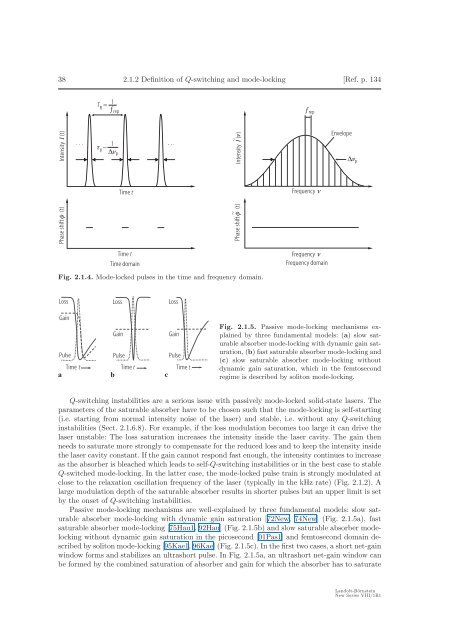2.1 Ultrafast solid-state lasers - ETH - the Keller Group
2.1 Ultrafast solid-state lasers - ETH - the Keller Group
2.1 Ultrafast solid-state lasers - ETH - the Keller Group
You also want an ePaper? Increase the reach of your titles
YUMPU automatically turns print PDFs into web optimized ePapers that Google loves.
38 <strong>2.1</strong>.2 Definition of Q-switching and mode-locking [Ref. p. 134<br />
T R<br />
= 1<br />
rep<br />
rep<br />
Intensity I (t)<br />
. . . . . .<br />
p ~ 1<br />
p<br />
.<br />
~<br />
Intensity I ( )<br />
Envelope<br />
p<br />
Time t<br />
Frequency <br />
Phase shift (t)<br />
~<br />
Phase shift (t)<br />
Time t<br />
Time domain<br />
Frequency <br />
Frequency domain<br />
Fig. <strong>2.1</strong>.4. Mode-locked pulses in <strong>the</strong> time and frequency domain.<br />
Loss Loss Loss<br />
Gain<br />
Gain<br />
Gain<br />
Pulse Pulse Pulse<br />
Time t Time t Time t<br />
a b c<br />
Fig. <strong>2.1</strong>.5. Passive mode-locking mechanisms explained<br />
by three fundamental models: (a) slow saturable<br />
absorber mode-locking with dynamic gain saturation,<br />
(b) fast saturable absorber mode-locking and<br />
(c) slow saturable absorber mode-locking without<br />
dynamic gain saturation, which in <strong>the</strong> femtosecond<br />
regime is described by soliton mode-locking.<br />
Q-switching instabilities are a serious issue with passively mode-locked <strong>solid</strong>-<strong>state</strong> <strong>lasers</strong>. The<br />
parameters of <strong>the</strong> saturable absorber have to be chosen such that <strong>the</strong> mode-locking is self-starting<br />
(i.e. starting from normal intensity noise of <strong>the</strong> laser) and stable, i.e. without any Q-switching<br />
instabilities (Sect. <strong>2.1</strong>.6.8). For example, if <strong>the</strong> loss modulation becomes too large it can drive <strong>the</strong><br />
laser unstable: The loss saturation increases <strong>the</strong> intensity inside <strong>the</strong> laser cavity. The gain <strong>the</strong>n<br />
needs to saturate more strongly to compensate for <strong>the</strong> reduced loss and to keep <strong>the</strong> intensity inside<br />
<strong>the</strong> laser cavity constant. If <strong>the</strong> gain cannot respond fast enough, <strong>the</strong> intensity continues to increase<br />
as <strong>the</strong> absorber is bleached which leads to self-Q-switching instabilities or in <strong>the</strong> best case to stable<br />
Q-switched mode-locking. In <strong>the</strong> latter case, <strong>the</strong> mode-locked pulse train is strongly modulated at<br />
close to <strong>the</strong> relaxation oscillation frequency of <strong>the</strong> laser (typically in <strong>the</strong> kHz rate) (Fig. <strong>2.1</strong>.2). A<br />
large modulation depth of <strong>the</strong> saturable absorber results in shorter pulses but an upper limit is set<br />
by <strong>the</strong> onset of Q-switching instabilities.<br />
Passive mode-locking mechanisms are well-explained by three fundamental models: slow saturable<br />
absorber mode-locking with dynamic gain saturation [72New, 74New] (Fig. <strong>2.1</strong>.5a), fast<br />
saturable absorber mode-locking [75Hau1, 92Hau] (Fig. <strong>2.1</strong>.5b) and slow saturable absorber modelocking<br />
without dynamic gain saturation in <strong>the</strong> picosecond [01Pas1] and femtosecond domain described<br />
by soliton mode-locking [95Kae1, 96Kae] (Fig. <strong>2.1</strong>.5c). In <strong>the</strong> first two cases, a short net-gain<br />
window forms and stabilizes an ultrashort pulse. In Fig. <strong>2.1</strong>.5a, an ultrashort net-gain window can<br />
be formed by <strong>the</strong> combined saturation of absorber and gain for which <strong>the</strong> absorber has to saturate<br />
Landolt-Börnstein<br />
New Series VIII/1B1
















